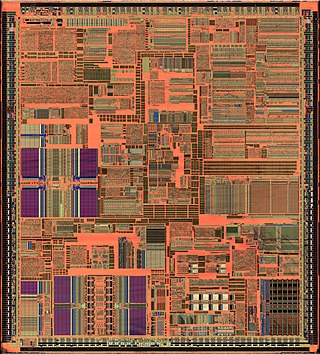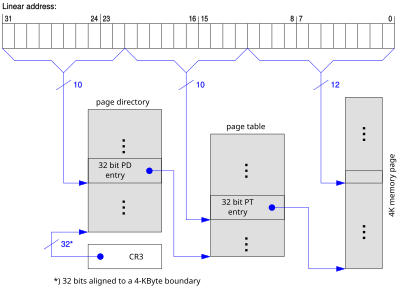IA-32 is the 32-bit version of the x86 instruction set architecture, designed by Intel and first implemented in the 80386 microprocessor in 1985. IA-32 is the first incarnation of x86 that supports 32-bit computing; as a result, the "IA-32" term may be used as a metonym to refer to all x86 versions that support 32-bit computing.

x86 is a family of complex instruction set computer (CISC) instruction set architectures initially developed by Intel based on the Intel 8086 microprocessor and its 8088 variant. The 8086 was introduced in 1978 as a fully 16-bit extension of Intel's 8-bit 8080 microprocessor, with memory segmentation as a solution for addressing more memory than can be covered by a plain 16-bit address. The term "x86" came into being because the names of several successors to Intel's 8086 processor end in "86", including the 80186, 80286, 80386 and 80486 processors. Colloquially, their names were "186", "286", "386" and "486".
In computer architecture, 64-bit integers, memory addresses, or other data units are those that are 64 bits wide. Also, 64-bit central processing units (CPU) and arithmetic logic units (ALU) are those that are based on processor registers, address buses, or data buses of that size. A computer that uses such a processor is a 64-bit computer.
In computing, protected mode, also called protected virtual address mode, is an operational mode of x86-compatible central processing units (CPUs). It allows system software to use features such as segmentation, virtual memory, paging and safe multi-tasking designed to increase an operating system's control over application software.

x86-64 is a 64-bit version of the x86 instruction set, first announced in 1999. It introduced two new modes of operation, 64-bit mode and compatibility mode, along with a new 4-level paging mode.
SSE2 is one of the Intel SIMD processor supplementary instruction sets introduced by Intel with the initial version of the Pentium 4 in 2000. It extends the earlier SSE instruction set, and is intended to fully replace MMX. Intel extended SSE2 to create SSE3 in 2004. SSE2 added 144 new instructions to SSE, which has 70 instructions. Competing chip-maker AMD added support for SSE2 with the introduction of their Opteron and Athlon 64 ranges of AMD64 64-bit CPUs in 2003.
The x86 instruction set refers to the set of instructions that x86-compatible microprocessors support. The instructions are usually part of an executable program, often stored as a computer file and executed on the processor.
In the 80386 microprocessor and later, virtual 8086 mode allows the execution of real mode applications that are incapable of running directly in protected mode while the processor is running a protected mode operating system. It is a hardware virtualization technique that allowed multiple 8086 processors to be emulated by the 386 chip. It emerged from the painful experiences with the 80286 protected mode, which by itself was not suitable to run concurrent real-mode applications well. John Crawford developed the Virtual Mode bit at the register set, paving the way to this environment.
The NX bit (no-execute) is a technology used in CPUs to segregate areas of a virtual address space to store either data or processor instructions. An operating system with support for the NX bit may mark certain areas of an address space as non-executable. The processor will then refuse to execute any code residing in these areas of the address space. The general technique, known as executable space protection, also called Write XOR Execute, is used to prevent certain types of malicious software from taking over computers by inserting their code into another program's data storage area and running their own code from within this section; one class of such attacks is known as the buffer overflow attack.

The P6 microarchitecture is the sixth-generation Intel x86 microarchitecture, implemented by the Pentium Pro microprocessor that was introduced in November 1995. It is frequently referred to as i686. It was planned to be succeeded by the NetBurst microarchitecture used by the Pentium 4 in 2000, but was revived for the Pentium M line of microprocessors. The successor to the Pentium M variant of the P6 microarchitecture is the Core microarchitecture which in turn is also derived from P6.
In computing, Intel's Advanced Programmable Interrupt Controller (APIC) is a family of programmable interrupt controllers. As its name suggests, the APIC is more advanced than Intel's 8259 Programmable Interrupt Controller (PIC), particularly enabling the construction of multiprocessor systems. It is one of several architectural designs intended to solve interrupt routing efficiency issues in multiprocessor computer systems.
System Management Mode is an operating mode of x86 central processor units (CPUs) in which all normal execution, including the operating system, is suspended. An alternate software system which usually resides in the computer's firmware, or a hardware-assisted debugger, is then executed with high privileges.
In computer security, executable-space protection marks memory regions as non-executable, such that an attempt to execute machine code in these regions will cause an exception. It makes use of hardware features such as the NX bit, or in some cases software emulation of those features. However, technologies that emulate or supply an NX bit will usually impose a measurable overhead while using a hardware-supplied NX bit imposes no measurable overhead.
In computing, Page Size Extension (PSE) refers to a feature of x86 processors that allows for pages larger than the traditional 4 KiB size. It was introduced in the original Pentium processor, but it was only publicly documented by Intel with the release of the Pentium Pro. The CPUID instruction can be used to identify the availability of PSE on x86 CPUs.
In computing, PSE-36 refers to a feature of x86 processors that extends the physical memory addressing capabilities from 32 bits to 36 bits, allowing addressing to up to 64 GB of memory. Compared to the Physical Address Extension (PAE) method, PSE-36 is a simpler alternative to addressing more than 4 GB of memory. It uses the Page Size Extension (PSE) mode and a modified page directory table to map 4 MB pages into a 64 GB physical address space. PSE-36's downside is that, unlike PAE, it doesn't have 4-KB page granularity above the 4 GB mark.
The PCI hole or PCI memory hole is a limitation of 32-bit hardware and 32-bit operating systems that causes a computer to appear to have less memory available than is physically installed. This memory addressing limitation and the later workarounds necessary to overcome it are functionally similar to the memory limits of the early 8088 IBM PC memory architecture.
The maximum random access memory (RAM) installed in any computer system is limited by hardware, software and economic factors. The hardware may have a limited number of address bus bits, limited by the processor package or design of the system. Some of the address space may be shared between RAM, peripherals, and read-only memory. In the case of a microcontroller with no external RAM, the size of the RAM array is limited by the size of the integrated circuit die. In a packaged system, only enough RAM may be provided for the system's required functions, with no provision for addition of memory after manufacture.
In computing, the term 3 GB barrier refers to a limitation of some 32-bit operating systems running on x86 microprocessors. It prevents the operating systems from using all of 4 GiB (4 × 10243 bytes) of main memory. The exact barrier varies by motherboard and I/O device configuration, particularly the size of video RAM; it may be in the range of 2.75 GB to 3.5 GB. The barrier is not present with a 64-bit processor and 64-bit operating system, or with certain x86 hardware and an operating system such as Linux or certain versions of Windows Server and macOS that allow use of Physical Address Extension (PAE) mode on x86 to access more than 4 GiB of RAM.
Second Level Address Translation (SLAT), also known as nested paging, is a hardware-assisted virtualization technology which makes it possible to avoid the overhead associated with software-managed shadow page tables.
Intel 5-level paging, referred to simply as 5-level paging in Intel documents, is a processor extension for the x86-64 line of processors to support multilevel page tables. It extends the size of virtual addresses from 48 bits to 57 bits, increasing the addressable virtual memory from 256 TB to 128 PB. The extension was first implemented in the Ice Lake processors.





